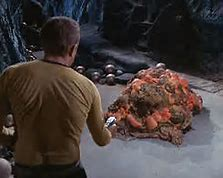Now let us talk about the life that has other than light as it's energy sourse for it's ecosystems. I'm talking about the organisms that exist in our sea floor spreading vents. Enabled by plate techteconics and a sufficient hydrosphere not necessarially liquid, (the magma at the vents can produce micro climate zones of melted ice filled with lots of chemicals for the lifeforms to metabalize). During the late bombardment phase on earth, all life EXCEPT the sea floor vent dwellers were 100% killed off, several times. Life recolonized the world from these vent organisims several times. Aparently inventing molecules that can get light energy to power metabolization is not that hard, though sometimes they get it wrong, (hence the ones using red light). Mars appears to have lost it's plate techtetonics and it's hydrosphere, but that does not mean there are not any living cells surviving in hydrothermic vents deep underground. Grandfather could have sent robots out to place cultures of hydrothermic vent lifeforms on a multitude of planets. And sophonts other than the Droyne could also spread such organisms either on purpose or by accident, as these lifeforms are extreameophiles.

